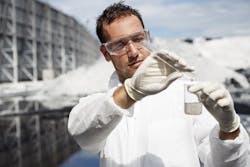Contaminants of Concern: E. coli and microcystin testing
Test enables rapid detection of E. coli in water
TORONTO — May 17, 2016 — Researchers at Canada’s York University developed a new test that enables early detection of Escherichia coli (E. coli) in drinking water.
The new technology simplifies the testing procedure, cutting down the time taken to detect E. coli from a few days to just a couple of hours. It is also an inexpensive way to test water samples, costing an estimated C$3 ($2.30) per test, which makes it suitable for use in developing countries.
The hydrogel based E. coli detection system turns red when E. coli is present, detecting the bacteria at the water source before people start drinking contaminated water, explained Professor Sushanta Mitra, associate vice president of research at York University.
The new testing device uses a porous hydrogel matrix developed by Mitra’s team at his Micro & Nano-scale Transport Laboratory which cages specific enzymatic substrates that release certain enzymes in E. coli cells. These enzymes then chemically react with the substrates to change color. If there is no E. coli, the color of the hydrogel will not change as there is no chemical reaction.
Insecticides used in urban areas are polluting streams
PORTLAND, Ore. — May 17, 2016 — A study published in the Journal of Environmental Monitoring and Assessment reveals that insecticide levels in streams flowing through the greater Portland metropolitan area during a September 2013 storm were above U.S. Environmental Protection Agency (EPA) benchmarks to protect aquatic life.
The active ingredients of insecticides detected by scientists included the chemicals bifenthrin, fipronil and malathion, as well as breakdown products of DDT. According to the study, the chemical that appeared to cause the most toxicity was bifenthrin, a broad-spectrum insecticide used to kill insect pests around homes and businesses.
This could harm beneficial insects when the sediments and associated chemicals settle out in streams, the U.S. Geological Service (USGS) explained.
Bifenthrin is contained in more than 600 products. Because of its high use and persistence in the environment, the chemical was detected in all five stormwater outfalls sampled for the study, and 73 percent of streams sampled during the storm, sometimes at levels well above EPA benchmarks. The researchers found that 71 percent of streams contained bifenthrin in streambed sediments at levels likely to affect aquatic insects.
The study showed that streams with no or low levels of bifenthrin in their sediments had significantly more aquatic insects such as mayflies, caddisflies and stoneflies than streams with high concentrations of bifenthrin. Streams with high sediment levels contained mostly pollution-tolerant organisms, primarily non-insects, USGS said.
Iowa DNR funds microcystin monitoring program
DES MOINES, Iowa — May 26, 2016 — The Iowa Department of Natural Resources (DNR) announced a voluntary program to test public drinking water supplies for microcystin.
Microcystin is a toxin that can be produced by blue-green algae and can be harmful to people and pets. Under the program, water utilities that use surface water (lake, river or reservoir) or groundwater under the influence of surface water as their source of water can apply for a share of the total $250,000 in funding for testing drinking water samples.
The DNR will pay for weekly shipping and analysis of raw (prior to any treatment) source water samples, and any treated water samples if raw water results indicate such testing is warranted, for one year or until the maximum funds allocated for the program have been expended.
According to the department, if tests show that raw water samples have more than 0.3 micrograms per liter, additional monitoring of both the raw and treated drinking water will be completed. If the treated water microcystin results are above 3 micrograms per liter on any two days during a 10-day period or consistently above 0.3 micrograms per liter during a 10-day period, the public will be notified and treatment processes will be changed to mitigate the occurrence.
Sampling is scheduled to start on Monday, July 11.
We could be breathing in microplastics, scientist warns
LONDON — May 9, 2016 — Tiny plastic particles are already known to harm marine life, but they may also be entering the air, professor Frank Kelly, a professor of environmental health at King’s College London, warned recently. Kelly told MPs in the United Kingdom that microplastics could enter the air after sewage sludge is spread on fields and dries out. He cited a French study that detected the particles in the air.
The committee was questioning academics on the environmental impact of microplastics.
Another expert, Dr. Erik van Sebille of the Grantham Institute for Climate Change at Imperial College London, told the committee that more should be done to reduce the amount of plastic pollution in the natural environment.
U.K. Environment Minister Rory Stewart told the House of Commons that Britain will consider banning plastic microbeads in products such as shower gels and facial scrubs if the European Union does not introduce a Europe-wide ban.
